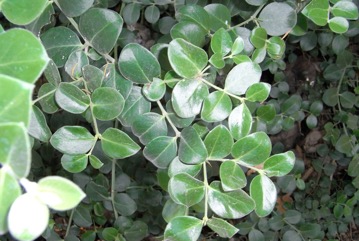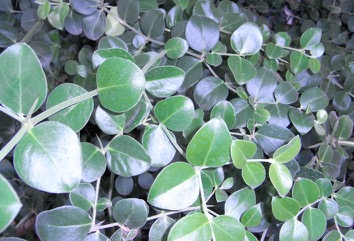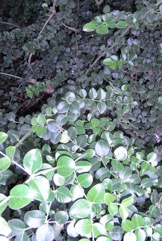Bengal currant

A tropical and subtropical plant. Salt tolerance is high. In Nepal it grows to 1000 m altitude. It suits dry sunny places. In India they are common on dry, sandy or loamy soils in the plains and low hills. It is very hardy and drought tolerant. It cannot tolerate heavy rainfall or waterlogged soils.
Also known as:
Avighna, Berenda, Caramba, Cay siro, Ci huang guo, Garchana kaayi, Kalakai, Kalakkay, Karamarda, Karamcha, Karanda, Karandan, Karande kaayi, Karaunda, Karaunte, Karekayi, Karonda, Karvanda, Karwand, Kerandang, Kerenda, Manaao ho, Naam daeng, Naam khee kaet, Nam-daeng, Perunkila, Senggaritan, Vaka, Wakay okachettu
Synonyms
- Arduina carandas (Linnaeus) K. Schumann
- Damna-canthus esquirolii H. Léveillé
- Carissa carandas Linn.
Edible Portion
- Fruit
Where does Bengal currant grow?
Found in: Asia, China, East Africa, East Timor, Himalayas, India, Indochina, Indonesia, Iran, Malaysia, Myanmar, Nepal, Northeastern India, Pacific, Pakistan, Philippines, SE Asia, Sri Lanka, Taiwan, Thailand, Timor-Leste, Vietnam
Notes: There about 20-37 Carissa species. All Carissa species bear edible fruit. They grow in the tropics and subtropics. Now Carissa spinarum.
Status: The fruit are sold in markets in India. It is a cultivated food plant.
Growing Bengal currant
Cultivation: Plants can be grown from seed. Plants can be kept clipped into a shrub otherwise they will be a climbing creeper. Plants can be grown from cuttings. Plants are often grown as a hedge.
Edible Uses: Fruit can be eaten fresh or used for juice or jelly. The can be very sour but ripe fruit are sweet. They are used for puddings, pickles, jams or as cooked fruit. The unripe fruit are pickled.
Production: Plants grown from seed fruit is the third year. A plant can keep producing for 30 years. A plant produces 4-5 kg of fruit. Fruit mature 100-110 days after fruit set. The fruit become darker and softer on ripening. In southern India plants fruit in April to May.
Nutrition Info
per 100g edible portion| Edible Part | Energy (kcal) | Protein (g) | Iron (mg) | Vitamin A (ug) | Vitamin c (mg) | Zinc (mg) | % Water |
|---|---|---|---|---|---|---|---|
| Fruit | - | - | - | - | - | - | |
| Fruit | 75 | 0.5 | - | - | 10 | - | 83 |
Bengal currant Photos



References
Aberoumand, A., 2008, Comparison of protein values from seven wild edible plants of Iran. African Journal of Food Science. Vol 2. pp 73-76 (As Carissa karandus)
Ambasta S.P. (Ed.), 2000, The Useful Plants of India. CSIR India. p 106 (As Carissa carandas)
Arora, R. K., 2014, Diversity in Underutilized Plant Species - An Asia-Pacific Perspective. Bioversity International. p 62
Bircher, A. G. & Bircher, W. H., 2000, Encyclopedia of Fruit Trees and Edible Flowering Plants in Egypt and the Subtropics. AUC Press. p 84 (As Carissa carandas)
Bole, P.V., & Yaghani, Y., 1985, Field Guide to the Common Trees of India. OUP p 69 (As Carissa carandas)
Burkill, I.H., 1966, A Dictionary of the Economic Products of the Malay Peninsula. Ministry of Agriculture and Cooperatives, Kuala Lumpur, Malaysia. Vol 1 (A-H) p 470 (As Carissa carandas)
Chandrashekara, U. M., 2009, Tree species yielding edible fruit in the coffee-based homegardens of Kerala, India: their diversity, uses and management. Food Sec. 1:361-370
Chin, H.F., & Yong, H.S., 1996, Malaysian Fruits in Colour. Tropical press, Kuala Lumpur p 61
Coronel, R.E., 1982, Fruit Collections in the Philippines. IBPGR Newsletter p 6 (As Carissa carandas)
Davis, S.D., Heywood, V.H., & Hamilton, A.C. (eds), 1994, Centres of plant Diversity. WWF. Vol 1 or 2. p 117 (As Carissa carandas)
Facciola, S., 1998, Cornucopia 2: a Source Book of Edible Plants. Kampong Publications, p 22 (As Carissa carandas)
Flora of Pakistan. www.eFloras.org (As Carissa carandas)
Flowerdew, B., 2000, Complete Fruit Book. Kyle Cathie Ltd., London. p 163 (As Carissa carandas)
GAMMIE (As Carissa carandas)
Hu, Shiu-ying, 2005, Food Plants of China. The Chinese University Press. p 630 (As Carissa carandas)
Janick, J. & Paul, R. E. (Eds.), 2008, The Encyclopedia of Fruit & Nuts. CABI p 70
Kiple, K.F. & Ornelas, K.C., (eds), 2000, The Cambridge World History of Food. CUP p 1745 (As Carissa carandas)
Krishen P., 2006, Trees of Delhi, A Field Guide. DK Books. p 95
Li Ping-tao; Antony J. M. Leeuwenberg, David J. Middleton, Apocynaceae, Flora of China Vol. 15 p 146 (As Carissa carandas)
Lyle, S., 2006, Discovering fruit and nuts. Land Links. p 105
Macmillan, H.F. (Revised Barlow, H.S., et al) 1991, Tropical Planting and Gardening. Sixth edition. Malayan Nature Society. Kuala Lumpur. p 296 (As Carissa carandas)
Manandhar, N.P., 2002, Plants and People of Nepal. Timber Press. Portland, Oregon. p 137 (As Carissa carandas)
Martin, F. W., et al, 1987, Perennial Edible Fruits of the Tropics. USDA Handbook 642 p 18 (As Carissa carandas)
McMakin, P.D., 2000, Flowering Plants of Thailand. A Field Guide. White Lotus. p 7 (As Carissa carandas)
Morton, Julia F., 1987, Fruits of Warm Climates. Creative Resources Systems, Inc. . p. 422
Patil, M. V. & Patil, D. A., 2000, Some More Wild Edible Plants of Nasik District (Maharashtra). Ancient Science of Life Vol. X1X (3&4): 102-104
PROSEA (As Carissa carandas)
Purseglove, J.W., 1968, Tropical Crops Dicotyledons, Longmans. p 626 (As Carissa carandas)
Sadhale, A., et al, 1991, Ethnobotanical studies of sacred grove at Ajiwali, Pune district. J. Econ. Tax. Bot. Vol. 15 No. 1 pp 167-172
Shah, G.L. et al, 1981, An account of the Ethnobotany of Saurashtra in Gujarat State (India). J. Econ. Tax. Bot. Vol 2 pp 173-182
Shah, G.L., 1984, Some economically important plant of Salsette Island near Bombay. J. Econ. Tax. Bot. Vol. 5 No. 4 pp 753-765
Sharma, B.B., 2005, Growing fruits and vegetables. Publications Division. Ministry of Information and broadcasting. India. p 76 (As Carissa carandas)
SHORTT (As Carissa carandas)
Singh, H.B., Arora R.K.,1978, Wild edible Plants of India. Indian Council of Agricultural Research, New Delhi. p 53
Singh, V. and Singh, P., 1981, Edible Wild Plants of Eastern Rajasthan. J. Econ. Tax. Bot. Vol 2 pp 197-207
Singh, V. B., et al, (Ed.) Horticulture for Sustainable Income and Environmental Protection. Vol. 1 p 214
Swaminathan, M.S., and Kochnar, S.L., 2007, An Atlas of Major Flowering Trees in India. Macmillan. p 207 (As Carissa carandas)
USDA, ARS, National Genetic Resources Program. Germplasm Resources Information Network - (GRIN). [Online Database] National Germplasm Resources Laboratory, Beltsville, Maryland. Available: www.ars-grin.gov/cgi-bin/npgs/html/econ.pl (10 April 2000) (As Carissa carandas)
Upreti, K., et al, 2010, Diversity and Distribution of Wild Edible Fruit Plants of Uttarakhand. Bioversity Potentials of the Himalaya. p 164
Verheij, E. W. M. and Coronel, R.E., (Eds.), 1991, Plant Resources of South-East Asia. PROSEA No 2. Edible fruits and nuts. Pudoc Wageningen. p 322 (As Carissa carandas)
Ravikrishna, S., 2011, Ethno-medico-botanical survey on Wild Edible fruits of Udupi Taluq, Udupi p 64 WATT. (As Carissa carandas)
Wong, K. C., 1995, Collection and Evaluation of Under-Utilized Tropical and Subtropical Fruit Tree Genetic Resources in Malaysia. JIRCAS International Symposium Series No. 3: 27-38
www.worldagroforestrycentre.org/treedb/